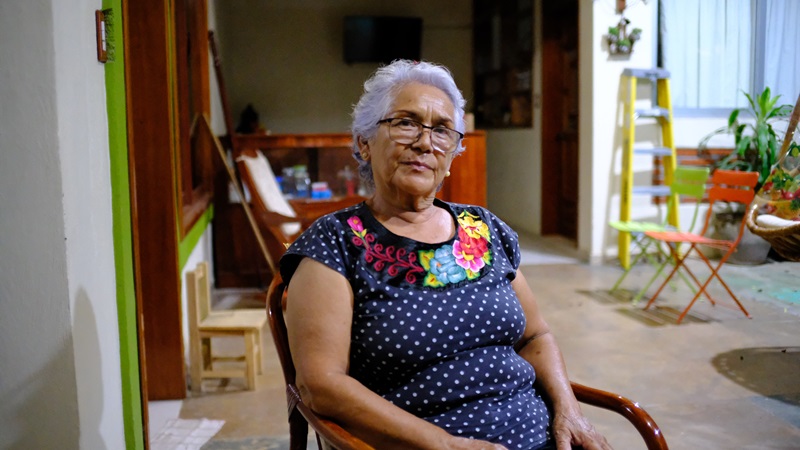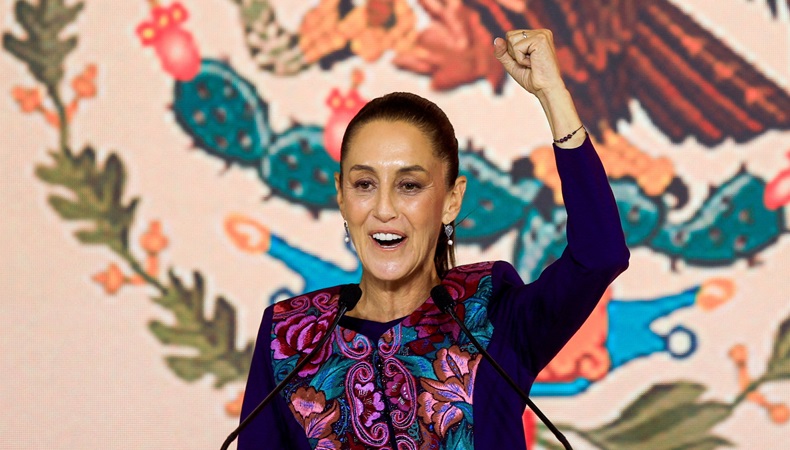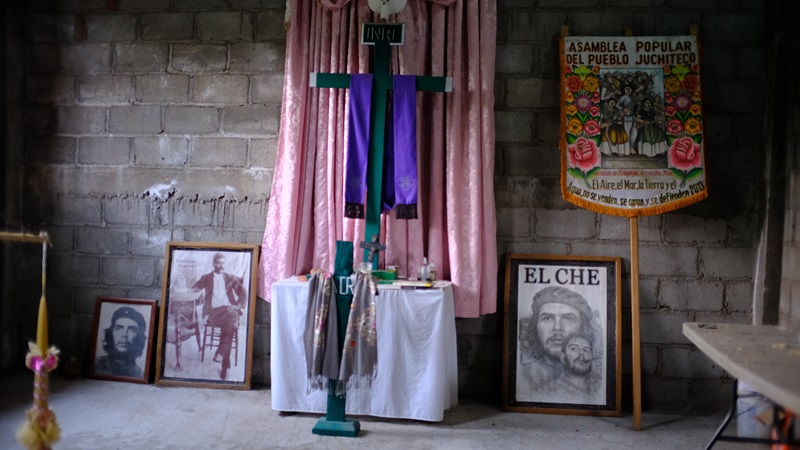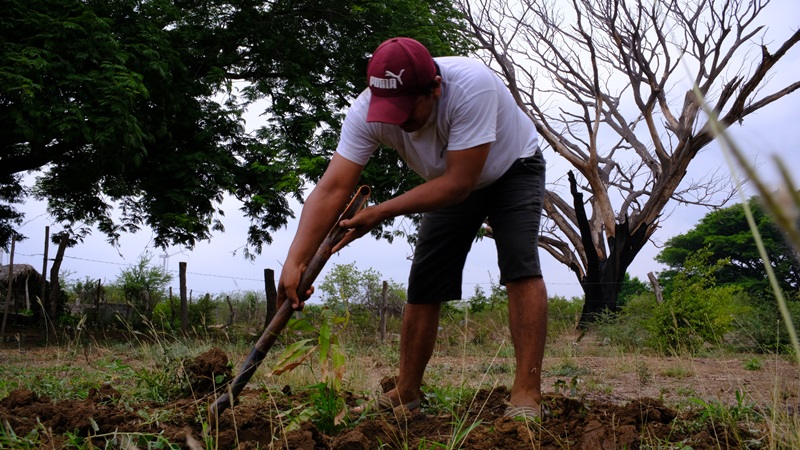Following years of violence surrounding one of Latin America’s largest wind energy projects, local residents in southern Oaxaca state are cautiously optimistic that Mexico’s incoming president understands their anger over what they call poor consultations and environmental damage.
Claudia Sheinbaum will be sworn in as Mexico’s first female president on October 1 with a broad electoral mandate. Before entering politics, she was a scientist studying renewable energy, including the ongoing conflict over wind farms on the Isthmus of Tehuantepec. The tensions have spawned deadly violence, and lawsuits from Oaxaca City to Paris.
One of Mexico’s windiest areas, energy companies have flocked to the strip of land between the Gulf of Mexico and the Pacific Ocean since 2006, making it one of the most important locations for renewable energy in the world’s 13th largest country.

Supporters say projects like this are crucial for transitioning Mexico away from fossil fuels and creating green jobs based on renewable energy. Opponents are concerned about wind turbines harming migratory birds, land access, revenue sharing and – most importantly – problems related to Indigenous community consultations over the investments.
Bloody conflict
In several cases, anger sparked by the projects has turned bloody, including at least 15 killed in a dispute over the wind farms in 2020.
Today, more than 2,000 turbines cover the land, according to data from Amnesty International, leading to “dispossession” and violations of the “collective rights of Indigenous communities”, the rights charity says. Hundreds of millions of dollars have been invested in the projects, mostly by European energy companies.

Anti-wind farm activist Guadalupe Ramirez poses for a picture inside her home in Union Hidalgo, Mexico. (Leon Pineda/Climate Home)
Guadalupe Ramirez is an Indigenous Zapotec farmer who grows pumpkins and corn on a communal plot in the town of Union Hidalgo, a hub for wind energy. She told Climate Home that “at first, they (wind companies) said they would just take a little piece of the land but they ended up destroying a big piece”.
“The companies started dividing families,” said Ramirez, who also complained about local environmental disruption from the projects. “We were very mad about this. I have hope with Sheinbaum.”
Ramirez expects the new president and former Mexico City mayor may have some unique insights on the problems her community faces. The academic turned politician co-authored a study analysing the unrest over wind projects in Oaxaca state.
“Although wind energy has numerous benefits, [the] concerns of the local people have to be taken seriously,” Sheinbaum wrote in 2016. “Far from the old-fashioned thinking of looking at social acceptance of renewable technologies as a NIMBY (not in my backyard) problem… information, consultation, and participation are key elements to the success and acceptance of wind farm projects.”

Sheinbaum celebrates her election victory in Mexico City on June 3, 2024. (REUTERS/Raquel Cunha TPX)
Those are exactly the elements Ramírez and many of her neighbours say were missing when they were first approached by energy companies back in 2009.
From there, the conflict escalated, said Carlos Lopez, who has experienced it firsthand. As an activist and community journalist in Union Hidalgo, he said he was threatened by masked men toting automatic weapons. He suspects they were hired by landowners or corrupt local politicians who wanted windmills erected in the area in order to receive rent from companies.
“They were killing people here,” Lopez told Climate Home, during an interview in a crumbling building which had been a community radio hub in Union Hidalgo as it underwent renovations.
In 2013, for instance, he said local fishermen and hunters were working in an area near Union Hidalgo coveted by wind investors, when they were accosted by masked men with heavy weapons. The fishermen then fled to the radio station, so Lopez could broadcast what was happening.
Deadly violence
“They [investors and their supporters in government] don’t respect the vision and culture of the original peoples of the Isthmus and want to push through these megaprojects,” said Lopez, sitting on a plastic chair next to pictures of Che Guevara and posters for protest movements.

Posters are displayed inside a community radio station in Union Hidalgo (Picture: Leon Pineda)
Residents later set up barricades around six areas they considered sacred sites to stop encroachment by companies, he added, as threats continued and violence simmered.
In 2020, for instance, at least 15 people were killed in San Mateo del Mar, a coastal community in Oaxaca and a hotbed of Indigenous opposition to wind projects. Campaigners said they were stopped at a coronavirus checkpoint and shot at by supporters of a local mayor who backed the wind projects.
Last month, a French court allowed a civil case against the energy giant EDF to proceed after Indigenous people in Oaxaca argued the company failed to prevent violence and intimidation of wind farm opponents.
The violence has quietened down in the past few years due to national government policy changes and several court cases limiting new wind investment in the area, said local residents, including both critics and supporters of the projects.
Opposition is “political”
Not everyone in Union Hidalgo is opposed to the wind farms. On a rainy Saturday on his mango, avocado and guava farm, Dueter Toledo Ordonez told Climate Home: “These projects aren’t bothering me.”
“Some people don’t like it,” he said, with wind turbines in the distance, “but it’s all political … It’s clean energy; it’s the future.”
His father, who farms a nearby plot, had a contract with an energy company to install windmills on his land, added Ordonez, “but something happened with the politics and people said they were polluting” so the company stopped construction.

Deuter Toledo Ordonez tends to crops on his land in Union Hidalgo on June 8, 2024. (Photo: Leon Pineda)
Juqulia Elizabeth Lopez Ruiz, a spokesperson for the secretary of renewable energy for Juchitan district, told Climate Home the 28 wind parks in Tehuantepec bring a lot of jobs.
But she acknowledges some farmers aren’t happy about the projects. “To respond to these concerns: we have Indigenous assemblies where we decide the correct way to act with these wind farms,” she said.
As for concerns raised by wind farm opponents that some municipal lawmakers have been corrupted by energy companies, Lopez Ruiz said this was “just speculation”.
“At one point there was a candidate who had the support of the companies but he stopped being a candidate,” said the local government spokesperson, without naming the politician or discussing specifics of the case.
Saudi visa crackdown left heatwave-hit Hajj pilgrims scared to ask for help
Eduardo Martinez Noriegua is an ecologist with the environmental group Ecological Forum in Juchitan, which has conducted some monitoring around the projects.
He said local anger over potential disruptions to migratory bird populations from wind farms, increased litter, and soil and water contamination from the oil lubricating the turbines is justified.
“I believe the government is being very permissive with the quality control for these operations,” he said.
Energy nationalisation
When Sheinbaum takes office, she will be leading a country that gets nearly 80% of its electricity from fossil fuels and is one of only two G20 countries without a commitment to reach net-zero carbon emissions.
Her key political backer – the popular current president, Andres Manuel Lopez Obrador (AMLO) – invested heavily in new oil infrastructure, and asserted greater national control over the electricity market.
Mexico nationalised its oil industry in the 1930s, and AMLO has taken a similar approach to key materials for the energy transition, cancelling lithium mining concessions granted to foreign firms and creating a new national company to extract the critical mineral.
EU “green” funds invest millions in expanding coal giants in China, India
The Federal Electricity Commission (CFE), a state agency, was also given more control over power generation and distribution.
Sheinbaum has signalled she will continue her predecessor’s policies of state dominance in the energy sector.
Despite the government’s “quest to nationalise electricity generation”, Marilyn Christian, an advisor to the Mexican Centre for Environmental Law, an advocacy group, said the CFE doesn’t currently have the technology to rapidly increase renewable power production. Instead, as demand grows, it has turned to fossil fuels to generate electricity.
“Emissions in the electricity sector … have been on the rise since 2021 – that is bad news for our commitments on reducing carbon emissions,” she said. “We have many expectations with Claudia Sheinbaum. She has a solid academic background in environmental issues … [but] Claudia is also a politician. She has a clear position and ideology.”
Christian said she supports the idea of public control over electricity in principle, an effective option in some European countries, but it will only work if the CFE has the capacity to deliver.
Back in Union Hidalgo, most wind farm critics said their views wouldn’t change if a public institution like the CFE, rather than private companies, managed the projects, posing another complication for generating more renewable power.
But some of the changes recommended by Sheinbaum in her study on Oaxaca – including deeper consultation with communities living nearby and taking their concerns seriously – could help smooth things out, Ramirez said.
“We are not totally against this kind of green energy,” she said as hundreds of white windmills whirred in the distance. “It’s about how they do business.”
(Reporting by Chris Arsenault and Philippe Le Billon, editing by Joe Lo and Megan Rowling)
The travel and reporting for this story were funded by a grant from the Global Reporting Centre and Social Sciences Humanities and Research Council.
